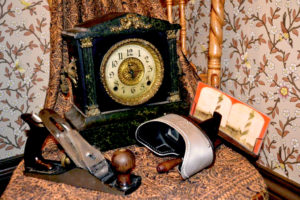”Don’t Touch!” is a familiar museum mantra. Art and antiques are roped off or sealed into glass cases and visitors are expected to maintain a respectful distance. This is certainly important for delicate art, fragile textiles and rare treasures, but are we really getting a sense of the object and the people who used it?
An antique automobile can be as beautiful as any sculpture but only the sight, sound and smell of a car in motion can convey its full story. The whistle of a toy train or the cuddly feel of a teddy bear can put us in the shoes of the child who loved it. Collectors enjoy operating vintage bicycles and machinery and have become experts on the sustainable use of their own favorite “toys.”
Many museums advocate responsible handling of selected objects in their collections to bring to their audiences not just the sight, but also the sound and feel of the past.
Each night the St. Augustine Lighthouse reminds us that our story is one of an ancient maritime port. Its light shines a welcome to travelers as it did when it was first lit 140 years ago on October 15, 1874. The striped tower invites all to climb in the footsteps of past keepers. A photo could never convey the beauty of the beam at night or the feeling of ascending the great spiral staircase to be greeted by an unequalled view of the city and the ocean. Imagine the ancient city’s night sky without its iconic light or a visit to the Lightner Museum without a concert played on its spectacular music machine collection.
What about your family treasures? Which should be protected as delicate objects and which can be put to careful use? Responsible handling and maintenance of tools, vintage clothing and household objects can give them a long life and give you a deeper sense of connection with the people who used them. Coffee prepared in your grandmother’s grinder somehow tastes better and old records played on a Victrola can give you a better sense of your great-grandfather’s life and surroundings than any digital reproduction, but these treasures must be used and handled with care.
Phonographs, watches and other mechanical objects need to be properly cleaned and lubricated to prevent wear and fine china and silver must never go into a dishwasher or microwave. Rinse salt from cars and bicycles after each ride. Proper cleaning after use and careful storage are key, but each object has its own needs. Fortunately, there are many resources available to help you decide which of your treasures can or should be put to use, and how to use them safely.
For information on caring for your personal collections:
Click on the links below for tips from museum professionals:
- The Henry Ford Museum shares a comprehensive guide to caring for your personal collections, arranged by type and material:http://www.thehenryford.org/research/caring.aspx
- The Library of Congress also has excellent advice on caring for family treasures and personal :http://www.loc.gov/preservation/family/
Kathleen McCormick has almost two decades of experience in museum conservation. She is currently the Director of Museum Conservation at the St. Augustine Lighthouse & Museum.
This article was originally published in The St. Augustine Record.


